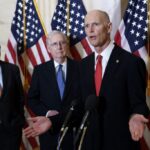Justice Brett Kavanaugh is expected to be the swing vote when the Supreme Court takes up a challenge to Roe v. Wade later this year. A review of the justice’s opinions suggests that he is open to overturning the landmark 1973 decision.
The Court will hear arguments on Dec. 1 in a case challenging Mississippi’s 15-week abortion ban. A clinic in Jackson, Miss., is attacking the law on constitutional grounds, and the state has responded by asking the Court to overrule Roe altogether. Kavanaugh is the most closely watched justice in the case, Dobbs v. Jackson Women’s Health Organization. Pro-choice forces need support from two Republican-appointed justices to preserve Roe.
The Court’s most conservative members—Justices Clarence Thomas, Samuel Alito, and Neil Gorsuch—make unlikely prospects, having criticized Roe to varying degrees. Justice Amy Coney Barrett is less certain, but she was associated with pro-life causes as a law professor and has questioned Roe‘s precedential weight in her scholarly writing. That leaves Chief Justice John Roberts as a prospective fourth vote, and Kavanaugh as a fifth.
Kavanaugh has written very little about abortion in 15 years on the federal bench. A canvass of those writings shows a preference for caution and restraint. But Kavanaugh has left a trail of anti-Roe breadcrumbs in his citations and approving references to pro-life authorities. Abortion was a dominant theme of Kavanaugh’s bitter confirmation fight, and a decision upholding Roe even in part would deflate social conservatives and ignite a circular firing squad in the GOP.
Red and blue states alike are readying legislation in case Roe is overturned. A glimpse into a post-Roe future is unfolding in Texas, where researchers contend the number of legal abortions has fallen by 50 percent since the state’s sweeping pro-life law took effect on Sept. 1. Clinics in Texas have curtailed services as they await word from the High Court as to whether their legal challenges to the act can proceed.
Prior to his nomination to the Supreme Court, Kavanaugh had written only one opinion in an abortion case, and it hardly cheered the pro-life side. The case, Garza v. Hargan, arose in 2017 after the Trump administration refused to provide an abortion for a pregnant teenager in a Texas immigration facility. The migrant teen was referred to as “Jane Doe” in court papers.
Though the government refused to schedule or pay for Doe’s abortion, it was willing to release her to an immigration sponsor who would arrange the procedure for her. The U.S. Court of Appeals for the D.C. Circuit ruled that the government was interfering with Doe’s rights, and it permitted her to have an abortion immediately. Doe terminated her pregnancy the following day.
Kavanaugh wrote a restrained dissent. On the one hand, he emphasized the government has a right to promote childbirth. On the other hand, he left open the possibility that Doe had a right to an abortion under Supreme Court precedent. On balance, he said the appeals court should have given the administration more time to find a sponsor instead of hastily crafting a decision on the reproductive rights of noncitizens. And he framed release to a sponsor as the more compassionate approach.
“It surely seems reasonable for the United States to think that transfer to a sponsor would be better than forcing the minor to make the decision in an isolated detention camp with no support network available,” Kavanaugh wrote. “Again, that may be debatable as a matter of policy. But unconstitutional? I do not think so.”
Kavanaugh notably did not join Judge Karen LeCraft Henderson’s dissent, which argued straightforwardly that Doe had no right to an abortion because she wasn’t a U.S. citizen. The omission rankled a few pro-life activists and was used against him when former president Donald Trump was considering prospective Supreme Court nominees.
Kavanaugh showed the same tendency toward restraint in his first abortion case on the Supreme Court. June Medical Services, LLC v. Russo involved a challenge to a Louisiana law which required that abortion providers have admitting privileges at a nearby hospital. Critics said the law was a stealth clinic-closer. They claimed abortion providers have difficulty obtaining admissions privileges for logistical and political reasons, and they predicted two of the state’s three clinics would close if the law took effect.
Roberts and the Court’s four liberals temporarily blocked Louisiana’s law in February 2019. Kavanaugh angled for a compromise in a short solo dissent. He said the Court needed more information about the precise effects of the statute, and he suggested giving the state a short window to test the consequences of enforcement.
A year later the Court had to render a final yes or no on the statute. A five-justice majority struck down Louisiana’s law but divided as to the reasoning.
This time, Kavanaugh stayed in the background. He joined a portion of Alito’s dissent that argued the clinics had no basis for getting into court in the first place. And he briefly reiterated his view, expressed in the 2019 proceedings, that the Court “should remand the case for a new trial and additional factfinding.” Beyond those technical, procedural points, he said nothing about abortion doctrine generally.
Though Kavanaugh gave little away in Garza and June Medical, he hinted at anti-Roe sympathies in a 2017 speech to the American Enterprise Institute and a 2020 case about criminal procedure.
Former Supreme Court chief justice William Rehnquist, one of the two dissenters in Roe, was Kavanaugh’s subject in the 2017 address. In a section of the speech that touched on Rehnquist’s Roe dissent, Kavanaugh said with seeming approval that Rehnquist “was successful in stemming the general tide of freewheeling judicial creation of unenumerated rights that were not rooted in the nation’s history and tradition.”
He added that Rehnquist did much to limit “the Court’s role in the realm of social policy and [helped] to ensure that the Court operates more as a court of law and less as an institution of social policy.” It was the kind of oblique nod in the anti-Roe direction that is typical of a conservative Supreme Court aspirant.
Legal briefs in the Dobbs case are peppered with citations to a concurring opinion Kavanaugh wrote in a 2020 case, Ramos v. Louisiana. Ramos did not involve abortion, but Kavanaugh used the case as a vehicle to lay out his approach to precedent.
The opinion opens with a long list of cases in which the Court overturned or tinkered with its precedent. One of the cases Kavanaugh included was Roe‘s principal successor, Planned Parenthood v. Casey, in which the controlling opinion embraced Roe‘s “core holding” but rejiggered the legal analysis.
Including Casey in the list was notable in that Kavanaugh was acknowledging the Court’s past abortion doctrines have been refashioned over the years. That’s important because he went on to say that the Court should consider a given precedent’s stability and consistency over time when the justices weigh overruling it.
Kavanaugh voted with the five-justice majority that allowed Texas to enforce its novel heartbeat law in September. Though the justice indicated he’s willing to open the way for a legal challenge at a subsequent hearing in November, the September decision allowing enforcement of the act was widely perceived as a momentous break with the Court’s abortion precedents.
A decision in Dobbs is expected by summer 2022.






